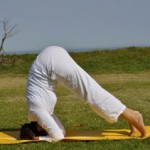Asana of the month – Shirshasana – the headstand
08/15/11
8 steps into Shirshasana:
start sitting on your heels
- measure the distance of your elbows and shoulders – hold your elbows and put them on the floor infront of you
- keeping the distance between your shoulders let go your elbows and interlace your fingers creating a support for your head
- put the crown of your head onto the floor inbetween your hands. already here start moving your shoulder away from you ears and feel that your forarms are strongly conected to the ground
- now lift you knees and straighten your legs. (you are in funny downward facing dog position now with your head and your forarms on the floor)
- walk your feet close to your head and feel the weight shifting on your arms and head. walk your feet as close to your head as possible so that you get the feeling that your feet want to lift of the ground
- slowly lift on leg and bend the knee, so that the knee is close to your body. when you feel balanced, and only then, you lift the other foot off the floor and also bend that knee into you chest. you are alreay standing on you head now. if you feel uncomfortable to go further just stay in this position to get used it. If you feel comfi take the next step
- slowly lift your knees and bring them inline with your hips. your feet come close to your bottocks. it helps to really engange you abdominal as well as your lower back muscles.
- and then from here you straigther you legs into Shirshasana, the full headstand
Benefits:
- increases the bloodflow back to the heart, strenghten the hear and heartbeat and also helps with varicose veins
- builds of muscles and strenghts in shoulders and arms
- increasing the bloodsupply in your brain and regulates the autonomic nervous system
- releases legs and pelvis
- enhances better balance
- stimulates the 3rd eye Chakra – the Ajna Chakra
Contraindications:
- high or low bloodpressure
- injuries in the neckarea
- during menstruation
- don’t do this asana in pregnancy unless your are very familiar with this pose and have been practising it for a long time







